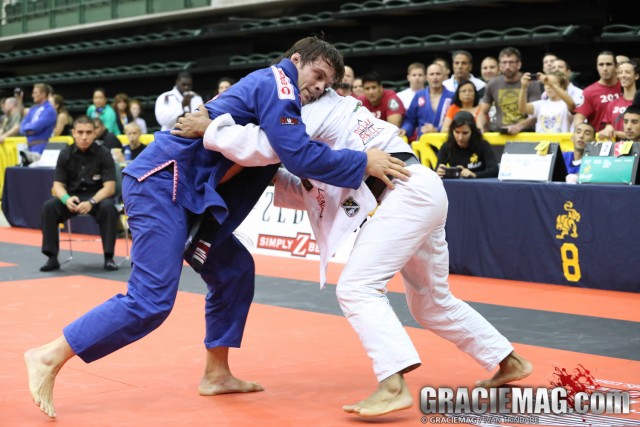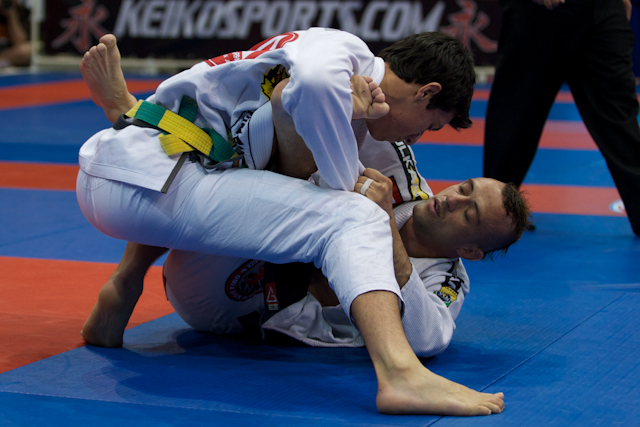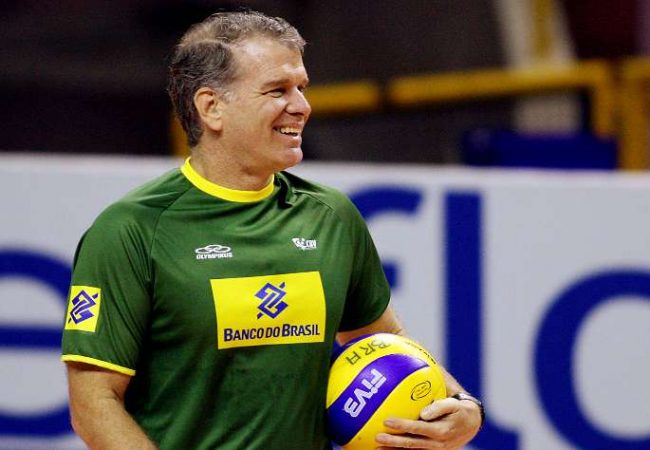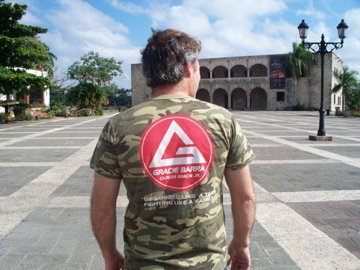 Around GBSC Coach Cullen is simply known as, “Dr. Steve.” Dr. Steve is a guy everyone loves, on the mats and off. He’s always willing to listen to students talk about their medical issues up at the school, he’s outgoing, friendly, kind, and sincere, but best of all, he’s a doctor with a great sense of humor. Dr. Steve always has a joke on hand to tell you or some funny story to make you laugh.
Around GBSC Coach Cullen is simply known as, “Dr. Steve.” Dr. Steve is a guy everyone loves, on the mats and off. He’s always willing to listen to students talk about their medical issues up at the school, he’s outgoing, friendly, kind, and sincere, but best of all, he’s a doctor with a great sense of humor. Dr. Steve always has a joke on hand to tell you or some funny story to make you laugh.
Recently, Dr. Steve, a “2nd degree” blue belt, showed his usual “black belt attitude” when the earthquake hit in Haiti. He didn’t think twice about it – he knew he had to go and help. Dr. Steve is an Internist and has his regular medical practice in San Clemente, but he is also part of a charitable organization called “Operation Rainbow.” Operation Rainbow is based out of San Francisco and is comprised of six different medical teams that travel to Central and South America to perform orthopedic surgery on children with crippling injuries and congenital deformities.
 Once a year, each Operation Rainbow group travels to a given destination. Once there, they evaluate 500 people and pick 50 to 80 to do surgery on, “My role as an internist,” Cullen says, “is to run the recovery room and hold clinics for high blood pressure and diabetes. I’m also the doc for our team, should they get sick. This emergency trip to Haiti was the first ever of its kind for Operation Rainbow. It was a strike-force for the earthquake victims. We’ve never put together a trip like this on such short notice.”
Once a year, each Operation Rainbow group travels to a given destination. Once there, they evaluate 500 people and pick 50 to 80 to do surgery on, “My role as an internist,” Cullen says, “is to run the recovery room and hold clinics for high blood pressure and diabetes. I’m also the doc for our team, should they get sick. This emergency trip to Haiti was the first ever of its kind for Operation Rainbow. It was a strike-force for the earthquake victims. We’ve never put together a trip like this on such short notice.”
In fact, the whole team only had 16 hours notice to get time off from work and collect the medical and surgical supplies needed for a trip like this, let alone pack for a week in a foreign country. That was followed by a 3am drive to LAX, a flight to Miami, a second flight to Santo Domingo in the Dominican Republic, and finally a 6-hour bus ride to the Haitian border.
Cullen didn’t eat any food during the day because he didn’t want to use the camp’s food supply”
 Cullen says it was chaos when they arrived on the scene, “We drove into a refugee camp in Jimani, in the Dominican Republic. It was two miles from the Haitian border. We didn’t know what to expect. We were responding to a natural disaster greater than what we’d ever seen before. Our surgeons quickly took leadership of the surgical community that was down there, and probably a hundred docs and nurses from all over the world worked together to orchestrate medical care.”
Cullen says it was chaos when they arrived on the scene, “We drove into a refugee camp in Jimani, in the Dominican Republic. It was two miles from the Haitian border. We didn’t know what to expect. We were responding to a natural disaster greater than what we’d ever seen before. Our surgeons quickly took leadership of the surgical community that was down there, and probably a hundred docs and nurses from all over the world worked together to orchestrate medical care.”
The refugee camp was at a site where there was a hospital, a chapel, and an orphanage. Those buildings and a number of tents quickly became hospital wards, “There were hundreds of patients in need of emergency medical care and surgery,” Cullen says, “They were laying everywhere – on mattresses inside the buildings and outside in the dirt. The 40-bed orphanage that we converted into a hospital housed 300 patients. It was busting at the seams. All in all, we had about 500 patients. We immediately started triaging them to different areas depending on their medical needs and we began to operate on people. Patients were put on antibiotics and pain control meds.”
What complicated matters was that there was no medical testing available, “We usually have access to medical testing, like blood tests and x-rays, but we didn’t have any of that. Doctors fixed fractures by guessing if bones were aligned correctly,” Cullen says, “Most of the victims had crushed bones, so we performed surgeries, put them in casts, or amputated limbs, but in war zones you’re not supposed to close wounds. You’re supposed to come back a week later to do formal amputations. Unfortunately, initial medical teams did amputations quickly and that led to post operative complications that we also had to deal with. Many victims got infections, so we ended up with bigger amputations. We had to remove many arms and legs.”
 What makes it more tragic is that many children operated on had no family left, “Kids woke up from anesthesia crying for their moms and dads, but they weren’t there. They were probably dead. Their homes collapsed after the earthquake. They were built into the sides of hills, staggered, one on top of each other with no support, so they didn’t stand a chance.”
What makes it more tragic is that many children operated on had no family left, “Kids woke up from anesthesia crying for their moms and dads, but they weren’t there. They were probably dead. Their homes collapsed after the earthquake. They were built into the sides of hills, staggered, one on top of each other with no support, so they didn’t stand a chance.”
Cullen was busy working when a 6.1 earthquake aftershock hit, “The Haitians were so traumatized from their initial earthquake experience, the aftershock sent them over the edge. One guy got so scared he threw his clothes and mattress over the 2nd story balcony and jumped. He broke his back and paralyzed himself. I tried to explain to everyone that the building we were in was safe, but none of the 300 patients would go back into the building after that. They pulled their mattresses outside and stayed there, regardless of their medical condition.”
Cullen’s wife, Cathy, is an R.N. and was also on the scene with him, “Cathy saved one man’s life. He was a burn victim with 40% of his body covered in 3rd degree burns. He sat outside of a hospital for six days with no medical care before he came to our camp. Cathy found him sitting outside. She brought him in and found a surgeon to perform surgery on him. Most would have died from infection. We kept him alive and we had him airlifted to the USS Comfort, where I hope he’s still alive today.”
 In fact, Cullen was instrumental in getting patients airlifted to the USS Comfort, a floating Naval Hospital, sent to help the earthquake victims, “On our 5th day, there was a rumor that the USS Comfort was going to start airlifting patients out. The US Navy sent a helicopter to our camp and the Dominican Republic decided to do the same. I was introduced to a Dominican general and I spoke with him in Spanish about the situation. I told him about some of our patients who desperately needed to be in a regular hospital to be treated for things we couldn’t do at the camp, and he initially agreed to one trip, then I got him to agree to multiple trips.”
In fact, Cullen was instrumental in getting patients airlifted to the USS Comfort, a floating Naval Hospital, sent to help the earthquake victims, “On our 5th day, there was a rumor that the USS Comfort was going to start airlifting patients out. The US Navy sent a helicopter to our camp and the Dominican Republic decided to do the same. I was introduced to a Dominican general and I spoke with him in Spanish about the situation. I told him about some of our patients who desperately needed to be in a regular hospital to be treated for things we couldn’t do at the camp, and he initially agreed to one trip, then I got him to agree to multiple trips.”
Cullen went on to say, “No matter what your profession and training, nothing prepares you emotionally for seeing a US Navy Black Hawk helicopter dropping down from the sky and whisking patients away in minutes. There was no better feeling than knowing my patients were going to a US Naval hospital that could house 1000 patients and give them the effective medical treatment they so badly needed.”
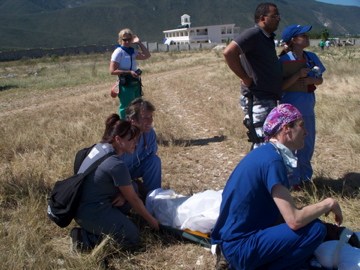 Cullen says he worked from 7am until 10pm at night. He didn’t eat any food during the day because he didn’t want to use the camp’s food supply. Cullen says the trip was an unparalleled experience, “It was crazy, heart breaking, and chaotic. Every second was amazing.”
Cullen says he worked from 7am until 10pm at night. He didn’t eat any food during the day because he didn’t want to use the camp’s food supply. Cullen says the trip was an unparalleled experience, “It was crazy, heart breaking, and chaotic. Every second was amazing.”
What Cullen wants people to know is that although the earthquake is over, Haitians have an uphill battle ahead, “These people will have to go back to Haiti. The Dominican Republic won’t let them live there. There is no prolonged care in Haiti. These patients will need more operations and they have no means to get them or prosthetics. Haiti is now a country filled with amputees and orphans. They had no belongings to begin with, but now they have no belongings, no money, and no homes. So, if people want to help, they can donate to charitable organizations that have already shown up like Operation Rainbow, and earmark their donations for Haitian relief. My team’s committed to going back in April to see what more we can do.” There’s that black belt attitude again…
If you want to help, go to: http://www.operationrainbow.org/


